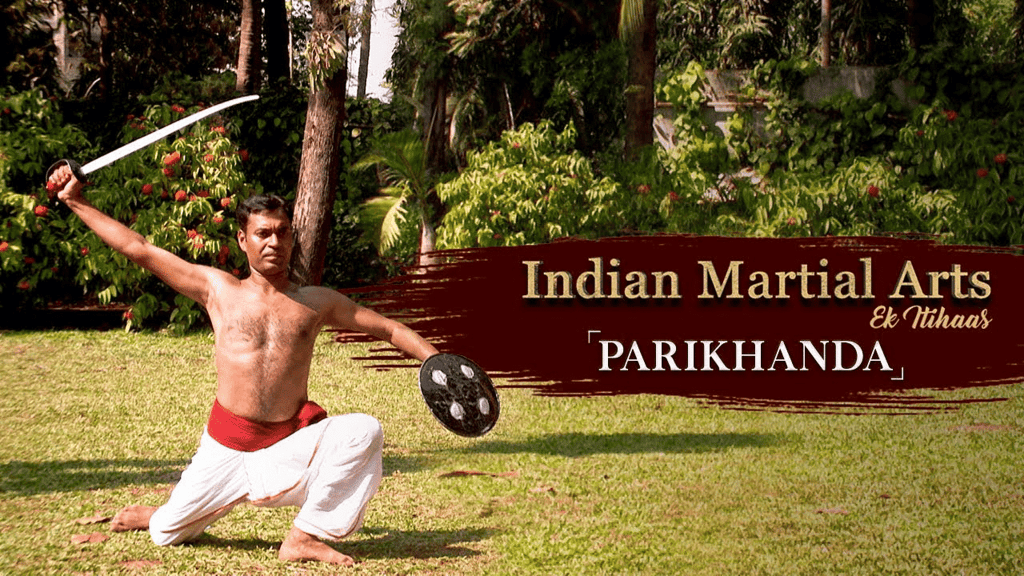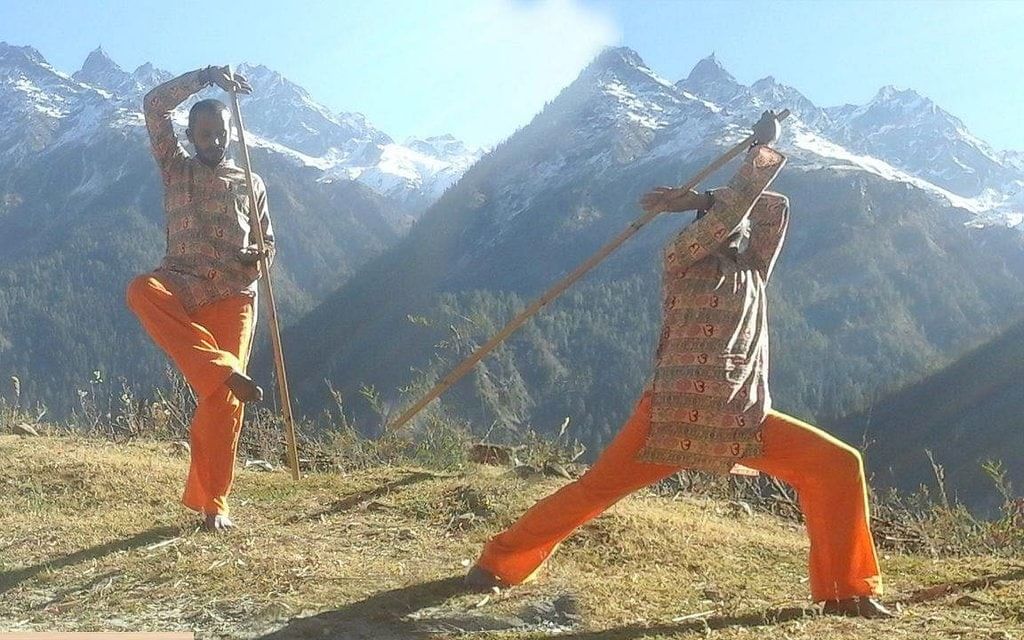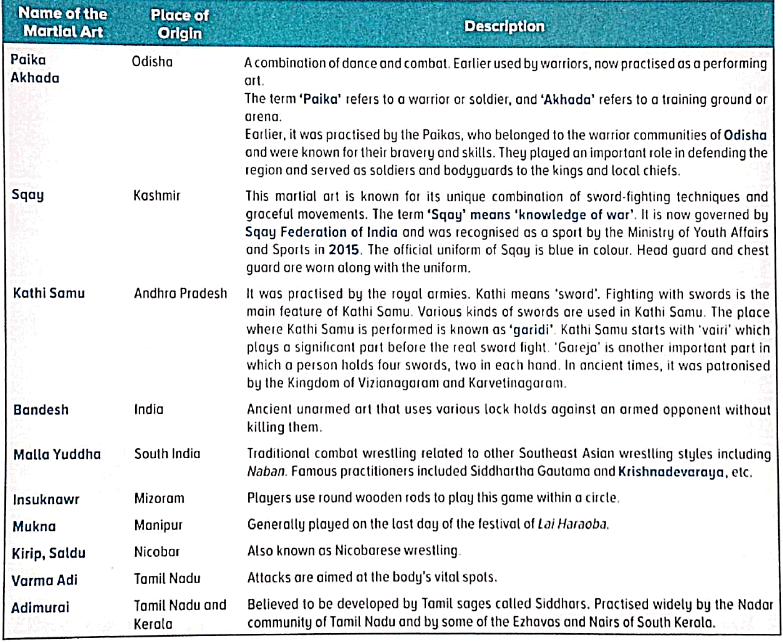Chapter 12: Martial Arts in India - UPSC PDF Download
History of Martial Arts in India
 Indian Martial Arts History
Indian Martial Arts History
An Overview of the Evolution of Martial Arts in India
- Vedic Texts (1500 BCE-600 BCE): A long time ago, in ancient texts called the Vedas, people talked about training and fighting. They mentioned things like archery, sword fighting, and training armies.
- Early Epics (600 BCE-400 CE): In old stories like the Ramayana and the Mahabharata, they told exciting tales about fighting skills. The Mahabharata had battles between heroes like Arjuna and Karna, using bows, swords, and even defeating lions with daggers.
- Regional Influence (200 BCE-1200 CE): In more recent times, different regions in India developed their own ways of fighting. For example, Kerala had 'Kalaripayattu,' Tamil Nadu had 'Silambam,' Manipur had 'Thang-ta,' and Punjab had 'Gatka.'
 Gatka, A Sikh Martial Art
Gatka, A Sikh Martial Art - Foreigner Invasions (1200 CE-1800 CE): When people from other countries came to India, they brought new ideas about fighting. This happened during invasions by the Mongols, Turks, Persians, Mughals, and Europeans. They influenced how people fought.
- Modernisation of Martial Arts (Late 19th Century — Present): In the late 1800s and early 1900s, things changed in how people did martial arts. Some experts and groups worked to keep the old ways alive but also make them fit with modern times.
Various Existing Forms of Martial Arts in India
India is a land with many different cultures, and it's known for having various martial arts that have been around since ancient times. Originally used for fighting in wars, these art forms are now often used for demonstrations, rituals, staying fit, or for self-defense.
The term "martial art" means 'arts associated with the waging of war.' Many martial art forms in India are closely connected to dance, yoga, and performing arts.

Kalaripayattu
 Silambam
Silambam
Kalaripayattu : The Ancient Martial Art of Kerala
Kalaripayattu, one of India's oldest martial arts, traces its roots to Kerala around the 3rd century BC. The term 'Kalari' in Malayalam refers to a special place where martial arts are taught. This art form involves mock duels, physical exercises, and focuses on fighting styles. Notable for its footwork, Kalaripayattu includes kicks, strikes, and weapon-based practices. Interestingly, both men and women practice this art, keeping traditional rituals alive.
Key Aspects of Kalaripayattu:
- Uzhichil: Massage with Gingli oil.
- Fighting with Otta: Using a stick shaped like an 'STM.'
- Maipayattu: Body exercises.
- Koltharipayattu: Use of wooden weapons.
- Angathari: Use of sharp metal weapons and sticks.
- Verumkai: Bare-handed fight.
This ancient art is even mentioned in Vadakkan Pattukal, a collection of Malayalam ballads from the medieval period, showcasing the warrior Chekavars of the Malabar region in Kerala.
Silabam : The Art of Staff Fencing
Silambam, a form of staff fencing from Tamil Nadu, is considered a modern and scientific martial art. Silambam
Silambam
- Historically promoted by the Pandyas, Cholas, and Cheras during their reign, Silambam's references can be found in ancient Tamil literature, including Silappadikaram from the 2nd century AD.
- The art form involved the sale of silambam staves, pearls, swords, and armor to foreign traders, with popularity extending to Rome, Greece, and Egypt.
- Silambam, believed to have expanded to Malaysia from its origin, serves both as a sport and a means of self-defense, using a long staff for mock fighting and practical techniques.
- Techniques in Silambam include swift foot movements, skillful use of both hands, and various strikes (thrusts, cuts, chops, and sweeps) to achieve mastery of force, momentum, and precision at different body levels.
- Self-defense strategies involve specific hits like snake hits, monkey hits, and hawk hits, aimed at diffusing mobs and deflecting thrown stones.
- The World Silambam Association (WSA), established in 1999, serves as the official governing body for Silambam, promoting and overseeing its practice globally.
Thang-ta and Sarit Sarak
- Thang-ta, an armed martial art, and Sarit Sarak, an unarmed combat form, were created by the Meitei people of Manipur.
 Thang-ta
Thang-ta - Originating in the 17th century, these arts were effectively used by Manipuri kings against the British.
- Despite being banned during British rule, these martial arts resurfaced after India gained independence.
- Thang-ta involves the use of a sword (Thang) and a spear (Ta), with both elements collectively known as Huyen Langlon.
- Gurumayum Gourakishor Sharma, a prominent practitioner of Huyen Langlon, was honored with the Padma Shri award in 2009.
Mallakhamb

- In 2013, Madhya Pradesh declared Mallakhamb as its state sport.
- References to Mallakhamb can be traced back to various sources, including the Ramayana, ancient pottery from Chandraketugarh (2nd to 1st century BC), and accounts of Buddhist Chinese pilgrims to India.
- The earliest literary mention is found in the 12th-century text Manasollasa by Chalukya king Someshvara-III.
- Mallakhamb is categorized into four types, named after Hindu gods and legendary fighters: Jarasandhi, Bhimaseni, Hanumanti, and Jambuvanti.
- Historically considered a sport for the less privileged, it has gained popularity, especially after being recognized by the Union Youth and Sports Ministry under Khelo India Youth Games.
Cheibi Gad-Ga
It is one of the oldest martial arts in Manipur.
- It originally involved a shield but has been adapted to use a stick and shield in modern times.
- The contest happens in a circle of 7 metres in diameter on a flat surface. Within the circle, there are two lines, about 2 meters apart .
- The Cheibi stick is about 2 to 2.5 feet long. The shield has a diameter of around 1 meter.
- Points are awarded during a duel based on a combination of skills and strength.
Pari-khanda
It is a martial art from Bihar, created by the Rajputs.
- It involves fighting using a sword and shield.
- The name "Pari-khanda" comes from two words: "Pari," which means shield, and "khanda," which means sword.
- Practitioners use both a sword and a shield in this martial art.
- The practice includes chaalis or steps, associated with movements like those of an elephant.
- Pari-khanda is still practiced in many parts of Bihar and is also used in Chhau dance.
Thoda
- Thoda originates from Himachal Pradesh, India.
- It is a part of the festivities during the Baisakhi festival held in April every year.
- Community prayers are offered to seek the blessings of Goddesses Mashoo and Durga, the principal deities.
Thoda traces its roots back to the times of the Mahabharata, an epic where bows and arrows were used in the battle, particularly in the valleys of Kullu and Manali. Thoda
Thoda
- Game Structure:
- Teams: There are two groups, namely Pashis and Saathis, each consisting of around 500 people.
- Participants: While not all are archers, many are dancers contributing to the team spirit.
- Court: The game is played in a marked court to maintain discipline.
- The martial art heavily relies on a player's archery skills. Archers aim for the legs, below the knee, as hitting other body parts results in negative points.
- Pashis and Saathis are believed to be the descendants of the Pandavas and Kauravas from the Mahabharata.
Gatka
Gatka is a traditional weapon-based martial art form performed by the Sikhs of Punjab, India.

- The term ‘Gatka’ signifies the one whose freedom is guided by grace.
- Gatka involves the skilled use of various weapons, including sticks, Kirpan (a ceremonial sword), Talwar (sword), and Kataar (dagger).
- Attack and defense in Gatka are determined by the different positions of hands and feet, as well as the nature of the weapon being used.
- It is often displayed during various celebrations and fairs in the state of Punjab.
- The Defendu system of martial art, developed by Captain William E. Fairbairn and Captain Eric Anthony Sykes before the Second World War, borrowed techniques from Gatka.
Mardani Khel
It is a traditional armed martial art originating from the state of Maharashtra, particularly practiced in the district of Kolhapur.
- The primary focus of Mardani Khel is on developing skills in weaponry, especially with swords. It emphasizes swift movements and employs low stances, suited to its origin in the hill ranges.
- It is known for the use of unique Indian weapons, namely the Patta (sword) and Vita (corded lance).

- Famous historical figures such as Shivaji and Tanaji Malusare were known practitioners of Mardani Khel.
- The martial culture of the Marathi people, including their martial arts, was noted by the Chinese monk Xuanzang in the 7th century.
Lathi
Lathi is an ancient martial art from India.
- The term "Lathi" refers to a stick (usually cane sticks) that is around 6 to 8 feet long, sometimes metal-tipped.
- It is recognized as one of the oldest weapons used in martial arts globally.
- Indian police often use Lathis to control crowds.
- The practice of Lathi is predominant in Punjab and Bengal and remains a popular sport in villages.
Inbuan Wrestling - Native Martial Art of Mizoram
Inbuan Wrestling is a native martial art originating from the northeastern state of Mizoram. It is believed to have originated in the year 1750 AD.
- The martial art has very strict rules that prohibit actions such as stepping out of the circle, kicking, and knee bending.

- The primary objective to win in Inbuan Wrestling is by lifting the opponent off their feet, and wrestlers must adhere stringently to the established rules.
- The wrestling involves the use of a belt worn around the waist, and catching or manipulating the opponent's belt is a part of the wrestling techniques.
Kuttu Varisai - Dravidian Martial Art
- First mentioned in Sangam literature, Kuttu Varisai translates to 'empty hand combat.'
- Mainly practiced in the Indian state of Tamil Nadu, Kuttu Varisai has gained popularity in the north-eastern parts of Sri Lanka and Malaysia.

- This is an unarmed Dravidian martial art, focusing on developing athleticism and footwork through practices like stretching, yoga, gymnastics, and breathing exercises.
- Kuttu Varisai involves various techniques, including grappling, striking, and locking. It incorporates sets inspired by animals such as snake, eagle, tiger, elephant, and monkey.
- It is considered as an unarmed component of Silambam, another traditional martial art.
Musti Yuddha
- Originated in the ancient city of Varanasi, Musti Yuddha is an unarmed martial art form that resembles boxing.
- Utilizes techniques such as kicks, punches, knee, and elbow strikes. Despite being rare in modern times, it was notably popular during the 1960s.
- Musti Yuddha emphasizes the development of all three aspects of training - physical, mental, and spiritual.
- Fights in Musti Yuddha are categorized into four, named after Hindu Gods:
- Jambuvanti: Focuses on forcing the opponent into submission through locking and holding.
- Hanumanti: Emphasizes technical superiority.
- Bhimaseni: Concentrates on sheer strengthJarasandhi: Focuses on limb and joint breaking.
- Jarasandhi: Focuses on limb and joint breaking.
Benefits of Practicing Martial Arts
Physical Fitness Boost:
- Exercise engages the whole body and the entire muscular system, leading to increased physical fitness.
- Activates the brain and contributes to enhanced strength, stamina, flexibility, movement, coordination, and more.

Emotional and Spiritual Well-being:
- Contributes to emotional and spiritual well-being.
- Traditional martial arts are known for their therapeutic effects.
FAQs on Chapter 12: Martial Arts in India - UPSC
| 1. What is the history of martial arts in India? |  |
| 2. What are some existing forms of martial arts in India? |  |
| 3. What are the benefits of practicing martial arts? |  |
| 4. Does UPSC provide any information or resources on martial arts in India? |  |
| 5. What are some frequently asked questions about martial arts in India? |  |
























